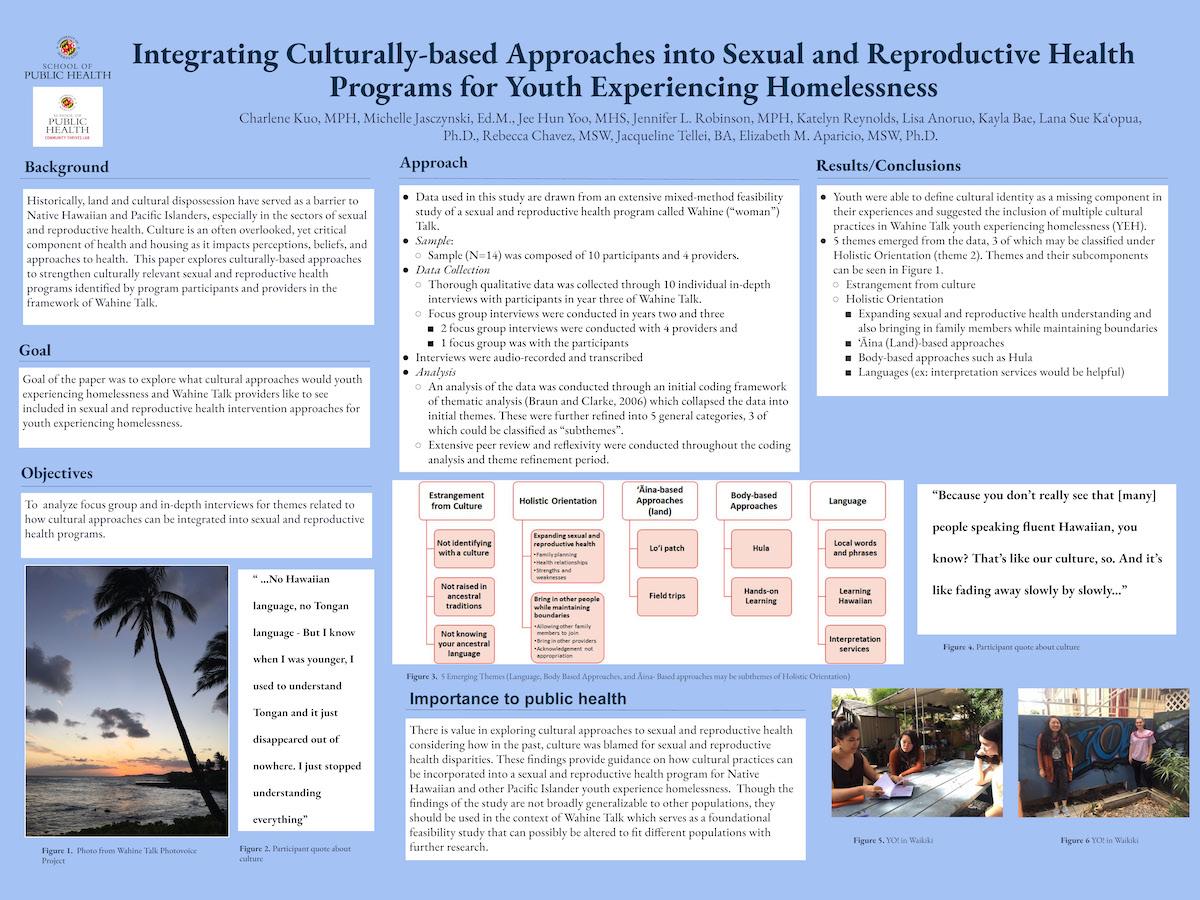
Poster # 1
Title: Integrating Culturally-based Approaches into Sexual and Reproductive Health Programs for Youth Experiencing Homelessness
Presenting Author: Lisa Anoruo (UMD SPH Public Health Science Student)
Authors: Charlene Kuo, MPH, SPHFaculty; Dr. Elizabeth M. Aparicio, MSW, PhD SPH Faculty; Michelle Jascynski, Ed.M, SPH Student/Faculty; Jee Hun Yoo, MHS, SPH Graduate student; Kayla Bae, SPH Student; Katelyn Reynolds, SPH, Student
Faculty Mentors: Charlene Kuo, MPH and Liz Aparicio, PhD as PI
Primary Category: Behavioral Health, Mental Health, Substance Abuse
Secondary Category: Family, Child, Adolescent Health (Includes Maternal and Child Health)
Background: Historically, land and cultural dispossession have served as a barrier to Native Hawaiian and Pacific Islanders, especially in the sectors of sexual and reproductive health. This paper explores culturally-based approaches to strengthen culturally relevant sexual and reproductive health programs identified by program participants and providers in the framework of Wahine Talk.
Goal: Goal of the paper was to explore what cultural approaches would youth experiencing homelessness and Wahine Talk providers like to see included in sexual and reproductive health intervention approaches for youth experiencing homelessness.
Objectives: To analyze focus groups and in-depth interviews for themes related to how cultural approaches can be integrated into sexual and reproductive health programs.
Approach/Methods: Data used in this study are drawn from an extensive mixed-method feasibility study of a sexual and reproductive health program called Wahine (“woman”) Talk. Sample: Sample (N=14) was composed of 10 participants and 4 providers. Data Collection Thorough qualitative data was collected through 10 individual in-depth interviews with participants in year three of Wahine Talk. Focus group interviews were conducted in years two and three 2 focus group interviews were conducted with 4 providers and 1 focus group was with the participants Interviews were audio-recorded and transcribed Analysis An analysis of the data was conducted through an initial coding framework of thematic analysis (Braun and Clarke, 2006) which collapsed the data into initial themes. These were further refined into 5 general categories, 3 of which could be classified as “subthemes”. Extensive peer review and reflexivity were conducted throughout the coding analysis and theme refinement period.
Results: Youth were able to define cultural identity as a missing component in their experiences and suggested the inclusion of multiple cultural practices in Wahine Talk youth experiencing homelessness (YEH).
5 themes emerged from the data, 3 of which may be classified under Holistic Orientation (theme 2). Themes and their subcomponents can be seen in Figure 1.
- Estrangement from culture
- Holistic Orientation
- Expanding sexual and reproductive health understanding and also bringing in family members while maintaining boundaries
- ‘Āina (Land)-based approaches
- Body-based approaches such as Hula
- Languages (ex: interpretation services would be helpful)
Importance to Public Health: There is value in exploring cultural approaches to sexual and reproductive health considering how in the past, culture was blamed for sexual and reproductive health disparities. Though the findings of the study are not broadly generalizable to other populations, they should be used in the context of Wahine Talk which serves as a foundational feasibility study that can possibly be altered to fit different populations with further research.
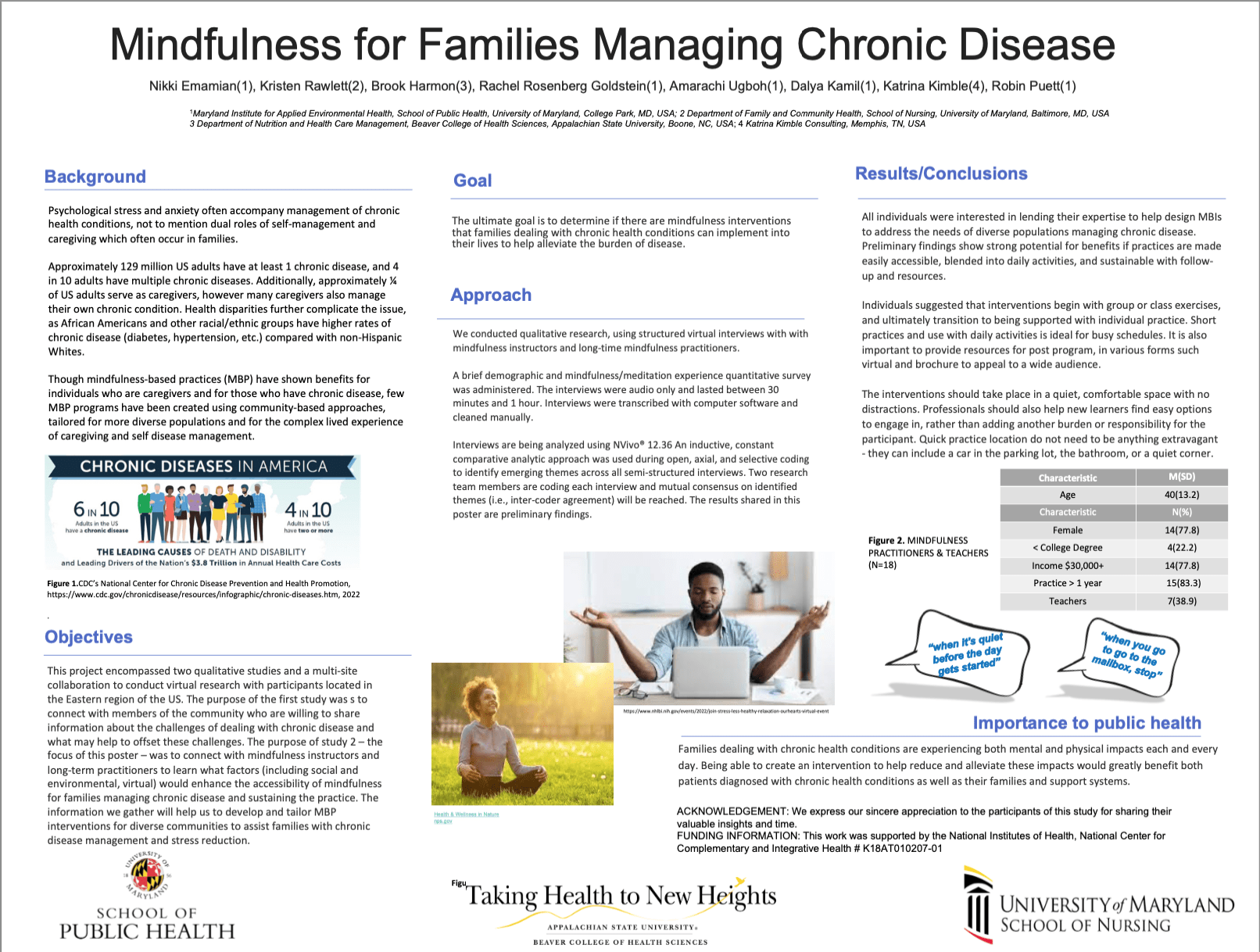
Poster # 2
Title: Mindfulness for Families Managing Chronic Disease
Presenting Author: Nikki Emamian (UMD SPH Public Health Science Student)
Authors: Kristen Rawlett, Brook Harmon, Chad McGehee, Rachel Rosenberg Goldstein, Amarachi Ugboh, Dalya Kamil, Nate West, Sarah Short, Robin Puett, PhD
Faculty Mentors: Robin Puett, PhD
Primary Category: Behavioral Health, Mental Health, Substance Abuse
Secondary Category: Data Analytics, Surveillance, Community Needs Assessment, Pedagogy
Background: Psychological stress and anxiety often accompany management of chronic health conditions, not to mention dual roles of self-management and caregiving which often occur in families. Through mindfulness-based practices (MBP) have shown benefits for individuals who are caregivers and for those who have a chronic disease, few MBP programs have been created using community-based approaches, tailored for more diverse populations and for the complex lived experience of caregiving and self disease management.
Goal: The ultimate goal is to determine if there are mindfulness interventions that families dealing with chronic health conditions can implement into their lives to help alleviate the burden of disease.
Objectives: We are examining what factors (including social and environmental, virtual) would enhance the accessibility of mindfulness for families managing chronic disease and sustaining the practice.
Approach/Methods: We conducted qualitative research using structured virtual interviews with adults managing their and their family members' health conditions with mindfulness instructors and long-time mindfulness practitioners.
Results: Preliminary findings show strong potential for benefits if practices are made easily accessible, blended into daily activities, and sustainable with follow-up and resources.
Importance to Public Health: Families dealing with chronic health conditions are experiencing both mental and physical impacts each and every day. Being able to create an intervention to help reduce and alleviate these impacts would greatly benefit both patients diagnosed with chronic health conditions as well as their families and support systems.
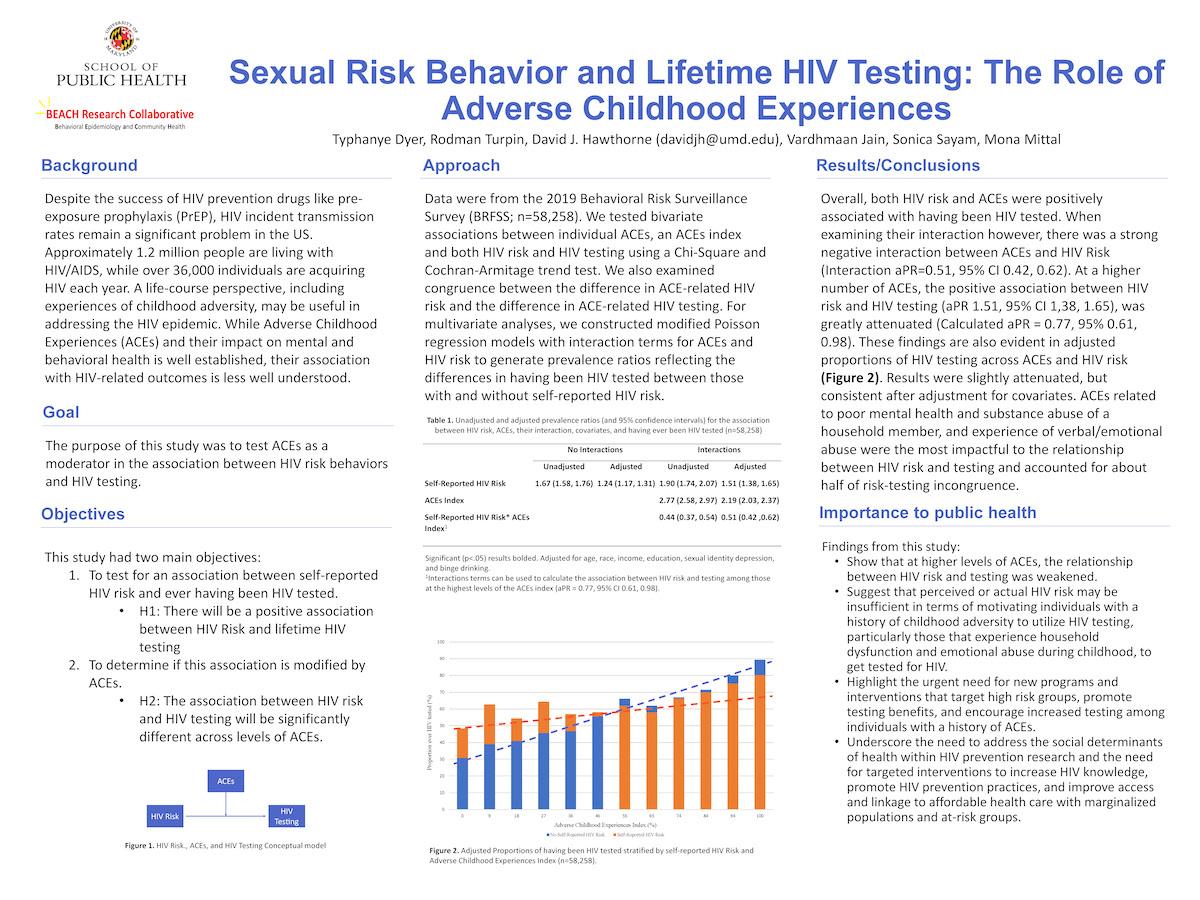
Poster # 3
Title: Sexual Risk Behavior and Lifetime HIV Testing: The Role of Adverse Childhood Experiences
Presenting Author: David Hawthorne (UMD SPH Doctoral Candidate in Behavioral and Community Health)
Authors: Typhanye Dyer, SPH Faculty; Rodman Turpin, SPH Faculty; Mona Mittal, SPH Faculty; Vardhmaan Jain, Cleveland Clinic; Sonica Sayam, SPH Student
Faculty Mentors: Mona Mittal, PhD; Typhanye Dyer, PhD; Rodman Turpin, PhD
Primary Category: Behavioral Health, Mental Health, Substance Abuse
Secondary Category: Data Analytics, Surveillance, Community Needs Assessment, Pedagogy
Background: Despite the success of HIV prevention drugs like pre-exposure prophylaxis (PrEP), HIV incident transmission rates remain a significant problem in the US.
Approximately 1.2 million people are living with HIV/AIDS, while over 36,000 individuals are acquiring HIV each year. A life-course perspective, including experiences of childhood adversity, may be useful in addressing the HIV epidemic. While Adverse Childhood Experiences (ACEs) and their impact on mental and behavioral health is well established, their association with HIV-related outcomes is less well understood.
Goal: The purpose of this study was to test ACEs as a moderator in the association between HIV risk behaviors and HIV testing.
Objectives: This study had two main objectives:
To test for an association between self-reported HIV risk and ever having been HIV tested.
-H1: There will be a positive association between HIV Risk and lifetime HIV testing
To determine if this association is modified by ACEs.
-H2: The association between HIV risk and HIV testing will be significantly different across levels of ACEs.
Approach/Methods: Data were from the 2019 Behavioral Risk Surveillance Survey (BRFSS; n=58,258). We tested bivariate associations between individual ACEs, an ACEs index and both HIV risk and HIV testing using a Chi-Square and Cochran-Armitage trend test. We also examined congruence between the difference in ACE-related HIV risk and the difference in ACE-related HIV testing. For multivariate analyses, we constructed modified Poisson regression models with interaction terms for ACEs and HIV risk to generate prevalence ratios reflecting the differences in having been HIV tested between those with and without self-reported HIV risk.
Results: Overall, both HIV risk and ACEs were positively associated with having been HIV tested. When examining their interaction however, there was a strong negative interaction between ACEs and HIV Risk (Interaction aPR=0.51, 95% CI 0.42, 0.62). At a higher number of ACEs, the positive association between HIV risk and HIV testing (aPR 1.51, 95% CI 1,38, 1.65), was greatly attenuated (Calculated aPR = 0.77, 95% 0.61, 0.98). These findings are also evident in adjusted proportions of HIV testing across ACEs and HIV risk (Figure 2). Results were slightly attenuated, but consistent after adjustment for covariates. ACEs related to poor mental health and substance abuse of a household member, and experience of verbal/emotional abuse were the most impactful to the relationship between HIV risk and testing and accounted for about half of risk-testing incongruence
Importance to Public Health: Findings from this study:
- Show that at higher levels of ACEs, the relationship between HIV risk and testing was weakened.
- Suggest that perceived or actual HIV risk may be insufficient in terms of motivating individuals with a history of childhood adversity to utilize HIV testing, particularly those that experience household dysfunction and emotional abuse during childhood, to get tested for HIV.
- Highlight the urgent need for new programs and interventions that target high risk groups, promote testing benefits, and encourage increased testing among individuals with a history of ACEs.
- Underscore the need to address the social determinants of health within HIV prevention research and the need for targeted interventions to increase HIV knowledge, promote HIV prevention practices, and improve access and linkage to affordable health care with marginalized populations and at-risk groups
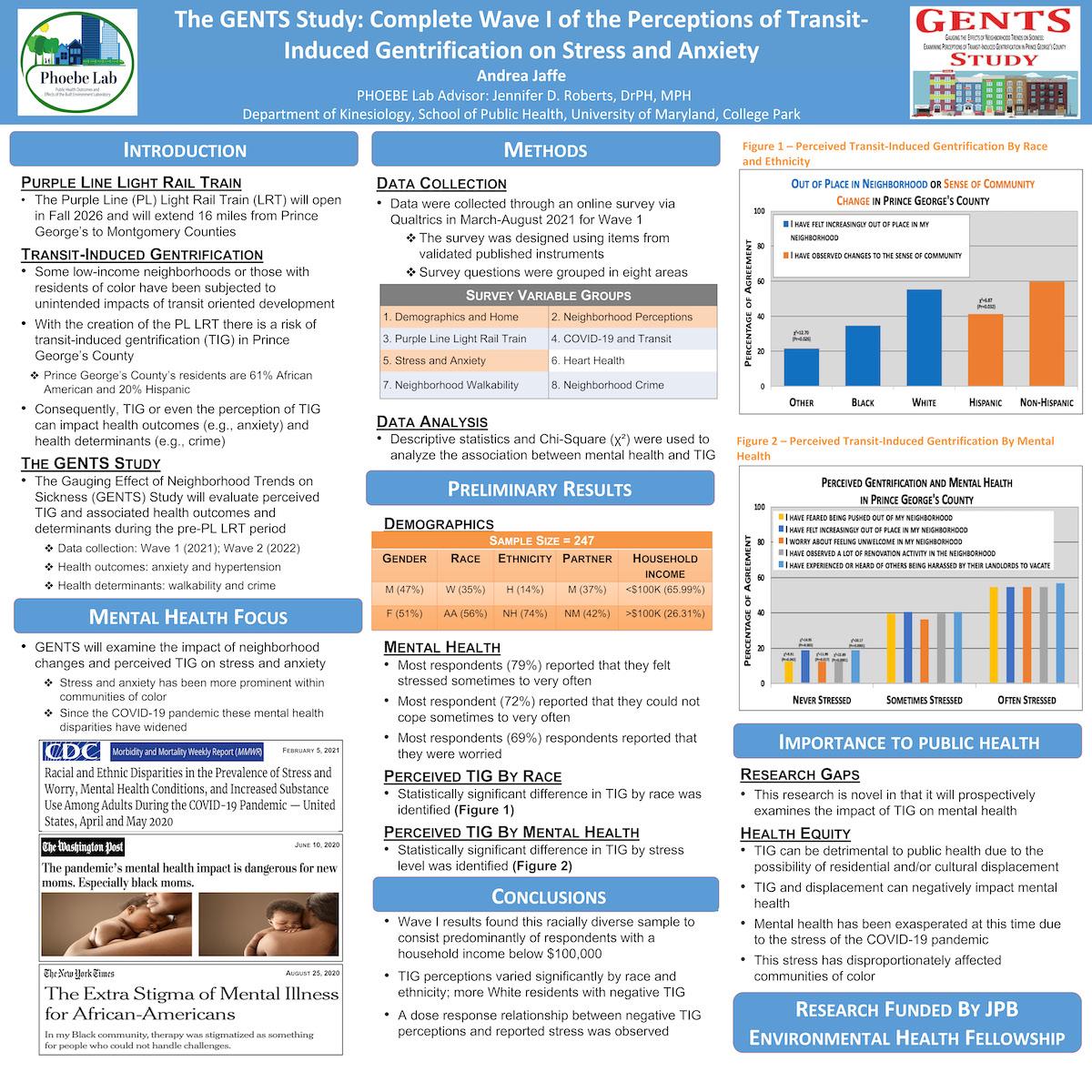
Poster # 4
Title: The GENTS Study: Complete Wave I of the Perceptions of Transit-Induced Gentrification on Stress and Anxiety
Presenting Author: Andrea Jaffe (UMD SPH Kinesiology Student)
Faculty Mentors: Jennifer D. Roberts, DrPH, MPH
Primary Category: Behavioral Health, Mental Health, Substance Abuse
Secondary Category: Healthy Equity, Racism and Social Injustice, Population Health, Immigration and Health
Background: With the future opening of the Purple Line (PL) light rail train (LRT) in Prince George’s (PG) County, Maryland, an area with 61% African American and 20% Hispanic residents, there may be transit induced gentrification (TIG), which could results in residential displacement and health impacts.
Goal: The GENTS Study will examine the effects of TIG on health outcomes, specifically stress and anxiety among PG County residents.
Objectives: The GENTS Study has (4) objectives.
- To assess perceived TIG
- To assess the prevalence of stress and anxiety
- To assess perceived TIG by race/ethnicity
- To assess perceived TIG by stress and anxiety
Approach/Methods: The GENTS Study collected data from PG County residents through an online questionnaire which was administered by Qualtrics.com. This questionnaire was launched in March 2021 and data were collected through August 2021 for Wave I. The GENTS questionnaire was designed using previously validated study instruments. Descriptive statistics and Chi Squares tests were used for data analysis.
Results: In the Complete Wave I of Preliminary data, the GENTS Study (n=247) includes 51% female; 47% male; 35% White, 56% African American; 2% Asian; 14% Hispanic, and 74% Non-Hispanic participants. Preliminary results found that 79% of respondents feel stressed, that 72% of respondents feel that they could not cope sometimes to very often, and that 69% of respondents feel worried. Almost 60% of white respondents feel increasingly out of place and have observed changes to the sense of community in their neighborhoods compared to less than 40% of African American respondents. Approximately 60% of Non-Hispanic respondents have observed changes to the sense of community compared to approximately 40% of Hispanic respondents. There is a dose response relationship between negative TIG perceptions and increasing stress level.
Importance to Public Health: LRT can cause gentrification within neighborhoods that can impact social determinants of health, such as walkability and crime, and health outcomes, such as heart health and anxiety. The gentrification that comes with the construction of LRT such as the PL can be beneficial to public health in terms of mental health by making an area more walkable and accessible, but it can also have negative impacts on public health due to the possibility that residents could become displaced, leading to poor mental health, which could lead to negative health outcomes.
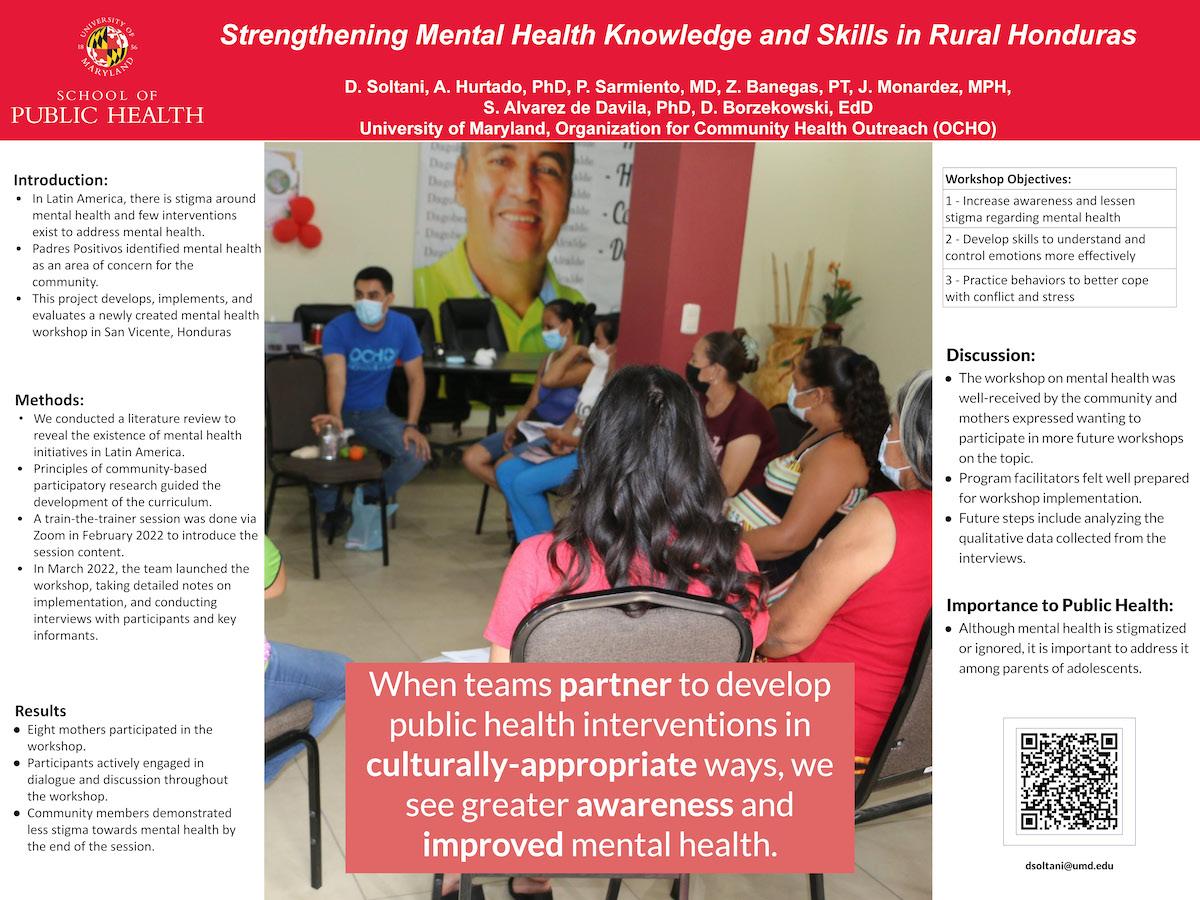
Poster # 5
Title: Strengthening Mental Health Knowledge and Skills in Rural Honduras
Presenting Author: Darya Soltani ( UMD SPH MPH Behavioral and Community Health Student)
Authors: Dina Borzekowski, SPH faculty; Ali Hurtado, UMD, faculty; Patrocinio Sarmiento, OCHO, community partner; Zasha Banegas, OCHO, community partner; Javiera Monardez, UMN, other; Silvia Alvarez de Davila, UMN, faculty
Faculty Mentors: Dina Borzekowski, Ph.D.
Primary Category: Behavioral Health, Mental Health, Substance Abuse
Secondary Category: Family, Child, Adolescent Health (Includes Maternal and Child Health)
Background: Although it is a topic of growing concern, mental health is often stigmatized; few interventions exist in Latin America to address it. Padres Positivos is a healthy parenting practices and youth development program in San Vicente, Honduras. Facilitators and participants identified the area of mental health as a topic of interest.
Goal: This project develops, implements, and evaluates the newly created mental health workshop.
Objectives: The workshop’s goals include 1) increasing awareness of and lessening stigma regarding mental health; 2) developing skills to understand and control emotions more effectively; and 3) practicing behaviors to better cope with conflict and stress.
Approach/Methods: The team conducted a literature review, using Pubmed and Google Scholar, to learn about existing mental health initiatives in Latin America. Based on this information, and following principles of community-based participatory research, the team created a curriculum and workshop for the parents of adolescent youth in San Vicente. OCHO, the Padres team, and a mental health professional, reviewed the curriculum and together adjusted the lessons. In February, a train-the-trainer session was conducted (via Zoom) to familiarize the team with the materials and best practices for implementation. In March 2022, the team traveled and observed the workshop’s implementation, took detailed notes, and conducted interviews with the facilitators and participants. The team will adjust the workshops based on information gained.
Results: Eight mothers participated in the workshop. Although the curriculum was followed closely, a few changes were made to accommodate the participants and resources available. The mothers participated very openly in the discussions. Focus group interviews were conducted with the mothers, revealing that the session content and format were well received and that they would like to attend more sessions on the topic. Interviews conducted with the program facilitators indicated that they felt prepared to implement the workshop.
Importance to Public Health: Poor mental health is a topic of growing concern around the world. Although this topic is either stigmatized or ignored, it is critical to address it among adolescents and their parents. This project is an example of how when teams partner to develop health interventions in culturally appropriate ways, we can bring awareness and improve mental health.
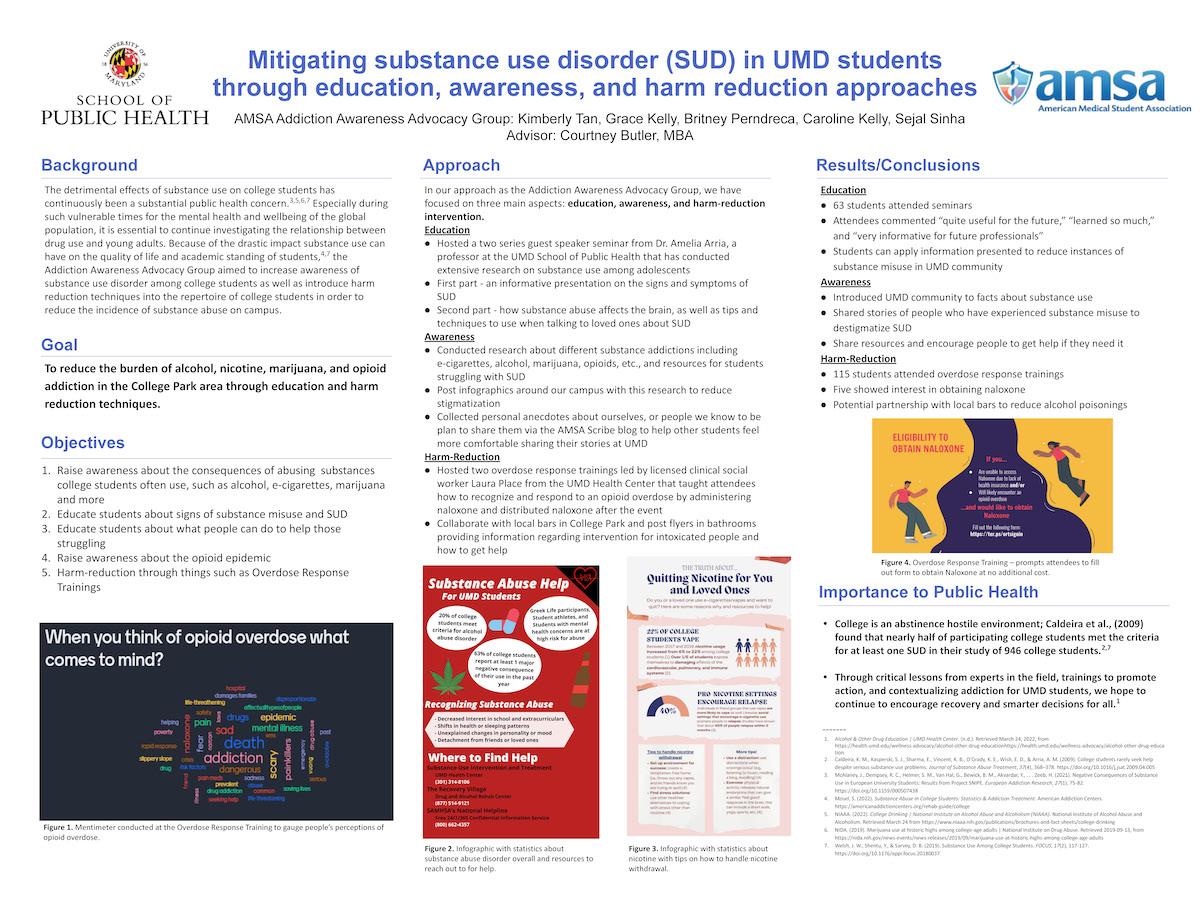
Poster # 6
Title: Mitigating substance use disorder (SUD) in UMD students through education, awareness, and harm reduction approaches
Presenting Author: Kimberly Tan (UMD SPH BS/MPH Public Health Science Student)
Authors: Grace Kelly, College of Computer, Mathematical, and Natural Sciences, Student; Sejal Sinha, College of Computer, Mathematical, and Natural Sciences, Student; Britney Perndreca, School of Public Health, Student; Caroline Kelly, A. James Clark School of Engineering, Student
Faculty Mentors: Courtney Butler
Primary Category: Behavioral Health, Mental Health, Substance Abuse
Secondary Category: Tobacco and Nicotine Products
Background: The detrimental effects of substance use on college students has continuously been a substantial public health concern. Especially during such vulnerable times for the mental health and wellbeing of the global population, it is essential to continue investigating the relationship between drug use and young adults. Because of the drastic impact substance use can have on the quality of life and academic standing of students, the Addiction Awareness Advocacy Group aimed to increase awareness of substance use disorder among college students as well as introduce harm reduction techniques into the repertoire of college students in order to reduce the incidence of substance abuse on campus.
Goal: To reduce the burden of alcohol, nicotine, marijuana, and opioid addiction in the College Park area through education and harm reduction techniques.
Objectives:
- Raise awareness about the consequences of abusing substances college students often use, such as alcohol, e-cigarettes, marijuana and more
- Educate students about signs of substance misuse and SUD
- Educate students about what people can do to help those struggling
- Raise awareness about the opioid epidemic
- Harm-reduction through things such as Overdose Response Trainings
Approach/Methods: In our approach as the Addiction Awareness Advocacy Group, we have focused on three main aspects: education, awareness, and harm-reduction intervention. Education: Hosted a two series seminar with Dr. Amelia Arria (Part 1: informative presentation on the signs and symptoms of SUD; Part 2: how SUD affects the brain, as well as tips and techniques to use when talking to loved ones about SUD). Awareness: conducted research to use for infographics to increase awareness about statistics revolving SUD and collect personal anecdotes to reduce stigmatization). Harm-reduction: hosted 2 overdose response trainings to teach attendees how to recognize and respond to an opioid overdose using Naloxone--then gave students the opportunity to obtain naloxone for free post-event; plans to collaborate with local bars to provide information about what to do in an alcohol overdose).
Results: Education: 63 students attended seminars; Attendees commented “quite useful for the future,” “learned so much,” and “very informative for future professionals”; Students can apply information presented to reduce instances of substance misuse in UMD community
Awareness: Introduced UMD community to facts about substance use; Shared stories of people who have experienced substance misuse to destigmatize SUD; Share resources and encourage people to get help if they need it
Harm-Reduction: 115 students attended overdose response trainings; Five showed interest in obtaining naloxone; Potential partnership with local bars to reduce alcohol poisonings
Importance to Public Health: College is an abstinence hostile environment; Caldeira et al., (2009) found that nearly half of participating college students met the criteria for at least one SUD in their study of 946 college students. Through critical lessons from experts in the field, trainings to promote action, and contextualizing addiction for UMD students, we hope to continue to encourage recovery and smarter decisions for all.
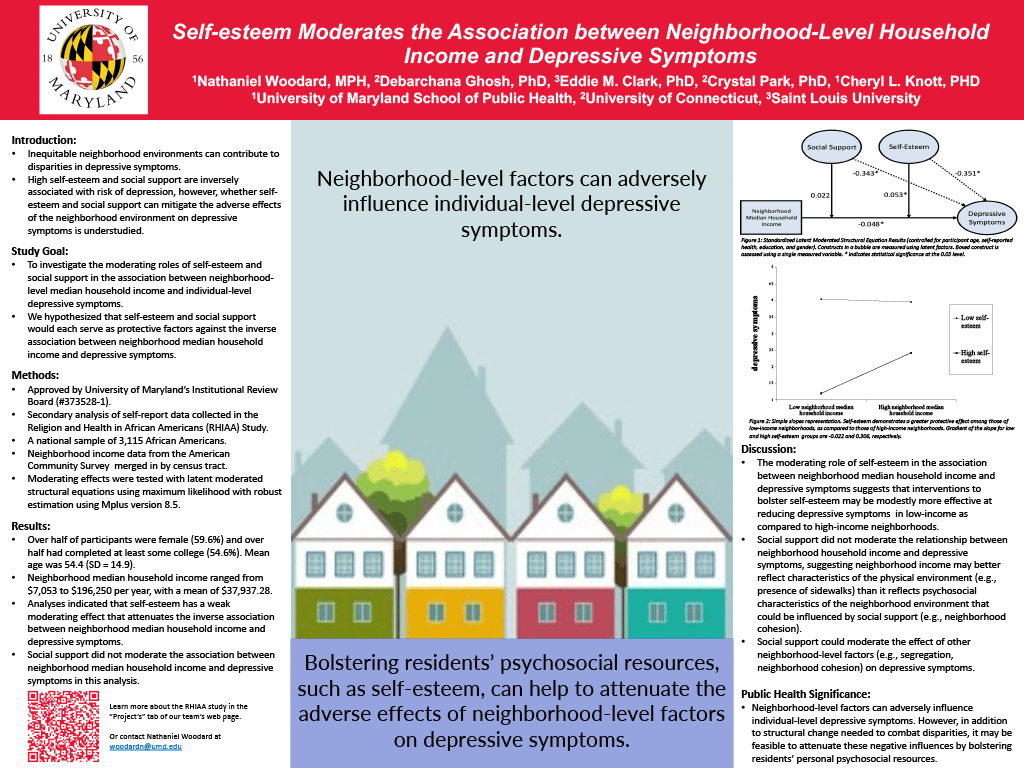
Poster # 49
Title: Self-esteem Moderates the Association between Neighborhood-Level Household Income and Depressive Symptoms
Presenting Author: Nathaniel Woodard
Authors: Debarchana Ghosh, PhD, Associate Professor; Department of Geography, University of Connecticut; Eddie M. Clark, PhD,Professor; Department of Psychology, Saint Louis University; Crystal Park, PhD, Professor, Department of Psychological Sciences, University of Connecticut;
Cheryl L. Knott, PhD, Professor, Department of Behavioral and Community Health, School of Public Health, University of Maryland
Faculty Mentors: Cheryl L. Knott, Ph.D.
Primary Category: Behavioral Health, Mental Health, Substance Abuse
Secondary Category:
Background: Recent research suggests that disadvantaged neighborhood environments can increase health disparities among inhabitants, including disparities of mental health and depression. Prior studies suggest high self-esteem and social support are inversely associated with one’s risk of depression, however, whether self-esteem and social support can mitigate the adverse effects of the neighborhood environment on depressive symptoms is understudied.
Goal: The current study investigates the moderating roles of self-esteem and social support in the association between neighborhood-level median household income and individual-level depressive symptoms in a national sample of 3,115 African Americans.
Objectives: We hypothesized that in addition to the direct effects of self-esteem and social support on depressive symptoms, self-esteem and social support would each serve as protective factors against the inverse association between neighborhood median household income and depressive symptoms.
Approach/Methods: Moderating effects were tested with latent moderated structural equations using maximum likelihood with robust estimation.
Results: Analyses indicated inverse direct associations between neighborhood median household income, self-esteem, and social support with depressive symptoms, controlling for participant age, gender, education, and self-reported health status. Interaction terms for neighborhood median household income and self-esteem indicated that self-esteem modestly attenuates the inverse association between neighborhood median household income and depressive symptoms. No moderating effect was detected for social support.
Importance to Public Health: Findings suggest that interventions to address depressive symptoms may consider interventional components to bolster self-esteem, particularly in low-income communities of color.
